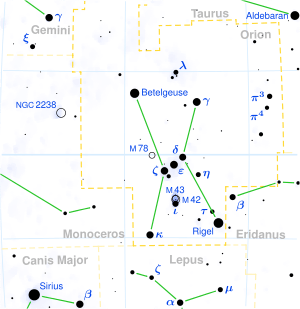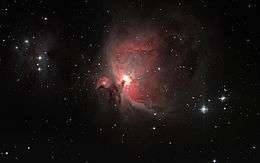Iota Orionis
 | |
| Observation data Epoch J2000 Equinox J2000 | |
|---|---|
| Constellation | Orion |
| Right ascension | 05h 35m 25.98191s[1] |
| Declination | –05° 54′ 35.6435″[1] |
| Apparent magnitude (V) | 2.77[2] |
| Characteristics | |
| Spectral type | O9 III + B0.8 III/IV[3] |
| U−B color index | –1.08[2] |
| B−V color index | –0.24[2] |
| Variable type | (B) Orion[4] |
| Astrometry | |
| Radial velocity (Rv) | 21.5[5] km/s |
| Proper motion (μ) | RA: +1.42[1] mas/yr Dec.: –0.46[1] mas/yr |
| Parallax (π) | 1.40 ± 0.22[1] mas |
| Distance | approx. 2,300 ly (approx. 700 pc) |
| Orbit[3][6] | |
| Period (P) | 29.1338 days |
| Semi-major axis (a) | 132 R☉ |
| Eccentricity (e) | 0.764 |
| Inclination (i) | ~60° |
| Periastron epoch (T) | 2,450,072.80 HJD |
| Details | |
| ι Ori Aa | |
| Mass | 23.1[6] M☉ |
| Radius | 8.3[6] R☉ |
| Luminosity | 68,000[6] L☉ |
| Surface gravity (log g) | 3.73[3] cgs |
| Temperature | 32,500[3] K |
| Metallicity [Fe/H] | +0.10[7] dex |
| Rotational velocity (v sin i) | 122[8] km/s |
| Age | 4.0–5.5[3] Myr |
| ι Ori Ab | |
| Mass | 13.1[6] M☉ |
| Radius | 5.4[6] R☉ |
| Luminosity | 8,630[6] L☉ |
| Surface gravity (log g) | 3.78[3] cgs |
| Temperature | 27,000[3] K |
| Age | 9.4 ± 1.5[3] Myr |
| ι Ori B | |
| Surface gravity (log g) | 4.0[9] cgs |
| Temperature | 18,000[9] K |
| Age | ~3[9] Myr |
| Other designations | |
| ι Ori A: 44 Orionis, HD 37043, HIP 26241, HR 1899, 2MASS J05352597-0554357 | |
| ι Ori B: V2451 Ori, 2MASS J05352645-0554445 | |
| ι Ori C: 2MASS J05352920-0554471 | |
| Database references | |
| SIMBAD | ι Ori |
| ι Ori B | |
| ι Ori C | |
Iota Orionis (ι Orionis, abbreviated Iot Ori, ι Ori) is a multiple star system in the equatorial constellation of Orion the hunter. It is the eighth-brightest member of Orion with an apparent visual magnitude of 2.77 and also the brightest member of the asterism known as Orion's Sword. It is a member of the NGC 1980 open cluster. From parallax measurements, it is located at a distance of roughly 2,300 light-years (710 parsecs) from the Sun.[1]
The system has three components designated Iota Orionis A, B and C. Iota Orionis A is itself a massive spectroscopic binary, with components Iota Orionis Aa (also named Hatysa[10]) and Ab.
Nomenclature
ι Orionis (Latinised to Iota Orionis) is the system's Bayer designation. The designations of the three constituents as Iota Orionis A, B and C, and those of A's components - Iota Orionis Aa and Ab - derive from the convention used by the Washington Multiplicity Catalog (WMC) for multiple star systems, and adopted by the International Astronomical Union (IAU).[11]
The system bore the traditional names Hatysa or Hatsya[12][13] In 2016, the IAU organized a Working Group on Star Names (WGSN)[14] to catalog and standardize proper names for stars. The WGSN decided to attribute proper names to individual stars rather than entire multiple systems.[15] It approved the name Hatysa for the component Iota Orionis Aa on 5 September 2017 and it is now so included in the List of IAU-approved Star Names.[10]
In Arabic the system was known as Na’ir al Saif, which means "the Bright One of the Sword."[16]
Properties

Iota Orionis is dominated by Iota Orionis A whose two components are a stellar class O9 III star (blue giant) and a class B0.8 III/IV star about 2 magnitudes fainter.[3] The collision of the stellar winds from this pair makes the system a strong X-ray source. Oddly, the two objects of this system appear to have different ages, with the secondary being about double the age of the primary. In combination with the high eccentricity (e=0.764) of their 29-day orbit, this suggests that the binary system was created through a capture, rather than by being formed together and undergoing a mass transfer. This capture may have occurred, for example, through an encounter between two binary systems.[3][17]
Iota Orionis B is a B8 giant at 11" (approximately 5,000 AU[9]) which has been shown to be variable, and likely to be a young stellar object.[18] The fainter Iota Orionis C is an A0 star at 49".[19]
NGC 1980 contains few bright stars other than Iota Orionis. Only eighteen other stars are considered members in a survey down to 14th magnitude, most of them around 9th magnitude but including the 5th magnitude stars HR 1886 and 1887.[20]
References
- 1 2 3 4 5 6 van Leeuwen, F. (November 2007), "Validation of the new Hipparcos reduction", Astronomy and Astrophysics, 474 (2): 653–664, arXiv:0708.1752, Bibcode:2007A&A...474..653V, doi:10.1051/0004-6361:20078357
- 1 2 3 Nicolet, B. (1978). "Photoelectric photometric Catalogue of homogeneous measurements in the UBV System". Astronomy and Astrophysics Supplement Series. 34: 1–49. Bibcode:1978A&AS...34....1N.
- 1 2 3 4 5 6 7 8 9 10 Bagnuolo, William G., Jr.; et al. (June 2001), "ι Orionis-Evidence for a Capture Origin Binary", The Astrophysical Journal, 554 (1): 362–367, Bibcode:2001ApJ...554..362B, doi:10.1086/321367
- ↑ Kazarovets, E. V.; Samus, N. N.; Durlevich, O. V.; Kireeva, N. N.; Pastukhova, E. N. (2011). "The 80th Name-List of Variable Stars. Part I - RA 0h to 6h". Information Bulletin on Variable Stars. 5969: 1. Bibcode:2011IBVS.5969....1K.
- ↑ Evans, D. S. (June 20–24, 1966), Batten, Alan Henry; Heard, John Frederick, eds., "The Revision of the General Catalogue of Radial Velocities", Determination of Radial Velocities and their Applications, University of Toronto: International Astronomical Union, 30: 57, Bibcode:1967IAUS...30...57E
- 1 2 3 4 5 6 7 Marchenko, Sergey V.; Rauw, Gregor; Antokhina, Eleonora A.; Antokhin, Igor I.; Ballereau, Dominique; Chauville, Jacques; Corcoran, Michael F.; Costero, Rafael; Echevarria, Juan; Eversberg, Thomas; Gayley, Ken G.; Koenigsberger, Gloria; Miroshnichenko, Anatoly S.; Moffat, Anthony F. J.; Morrell, Nidia I.; Morrison, Nancy D.; Mulliss, Christopher L.; Pittard, Julian M.; Stevens, Ian R.; Vreux, Jean-Marie; Zorec, Jean (2000). "Coordinated monitoring of the eccentric O-star binary Iota Orionis: Optical spectroscopy and photometry". Monthly Notices of the Royal Astronomical Society. 317 (2): 333. Bibcode:2000MNRAS.317..333M. doi:10.1046/j.1365-8711.2000.03542.x.
- ↑ Conti, P. S.; Loonen, J. P. (October 1970), "Coarse analysis of the helium weak B star Iota Ori B", Astronomy and Astrophysics, 8: 197–203, Bibcode:1970A&A.....8..197C
- ↑ Uesugi, Akira; Fukuda, Ichiro (1970), "Catalogue of rotational velocities of the stars", Contributions from the Institute of Astrophysics and Kwasan Observatory, University of Kyoto, Bibcode:1970crvs.book.....U
- 1 2 3 4 Conti, P. S.; Loonen, J. P. (1970). "Coarse analysis of the helium weak B star Iota Ori B". Astronomy and Astrophysics. 8: 197. Bibcode:1970A&A.....8..197C.
- 1 2 "Naming Stars". IAU.org. Retrieved 16 December 2017.
- ↑ Hessman, F. V.; Dhillon, V. S.; Winget, D. E.; Schreiber, M. R.; Horne, K.; Marsh, T. R.; Guenther, E.; Schwope, A.; Heber, U. (2010). "On the naming convention used for multiple star systems and extrasolar planets". arXiv:1012.0707 [astro-ph.SR].
- ↑ Kunitzsch, Paul; Smart, Tim (2006). A Dictionary of Modern Star Names. Sky Publishing. p. 62. ISBN 1931559449. Kunitzsch traces the name to Becvar's Atlas Coeli (1951), where it appeared as "Hatysa", but was unable to find an older source.
- ↑ Bakich, Michael E. (1995), The Cambridge Guide to the Constellations, Cambridge University Press, p. 118, ISBN 0521449219
- ↑ "IAU Working Group on Star Names (WGSN)". Retrieved 22 May 2016.
- ↑ "WG Triennial Report (2015-2018) - Star Names" (PDF). p. 5. Retrieved 2018-07-14.
- ↑ Allen, Richard Hinckley (1899), Star-names and their meanings, G. E. Stechert, p. 317
- ↑ "Runaways". Retrieved March 23, 2018.
- ↑ Abt, Helmut A. (2008). "Visual Multiples. IX. MK Spectral Types". The Astrophysical Journal Supplement Series. 176: 216–217. Bibcode:2008ApJS..176..216A. doi:10.1086/525529.
- ↑ Parenago, P. P. (1954). "Untersuchung der Sterne im Gebiet des Orion-Nebels. Tabelle III: Katalog der genauen Positionen. (Bestimmung von photographischen Beobachtungen)". Publ. Astr. Inst. Sternberg. 25: 393. Bibcode:1954TrSht..25....1P.
- ↑ Kharchenko, N. V.; Piskunov, A. E.; Röser, S.; Schilbach, E.; Scholz, R.-D. (2004). "Astrophysical supplements to the ASCC-2.5. II. Membership probabilities in 520 Galactic open cluster sky areas". Astronomische Nachrichten. 325 (9): 740. Bibcode:2004AN....325..740K. doi:10.1002/asna.200410256.
External links
- Iota Orionis by Dr. Jim Kaler.
- David Darling's encyclopedia entry